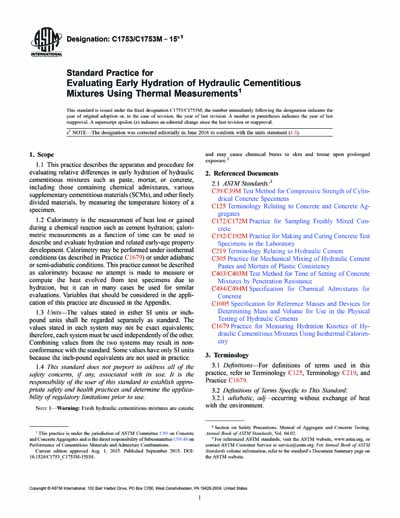Historical
ASTM C1753/C1753M-15e1
Standard Practice for Evaluating Early Hydration of Hydraulic Cementitious Mixtures Using Thermal Measurements
1.1 This practice describes the apparatus and procedure for evaluating relative differences in early hydration of hydraulic cementitious mixtures such as paste, mortar, or concrete, including those containing chemical admixtures, various supplementary cementitious materials (SCMs), and other finely divided materials, by measuring the temperature history of a specimen.
1.2 Calorimetry is the measurement of heat lost or gained during a chemical reaction such as cement hydration; calorimetric measurements as a function of time can be used to describe and evaluate hydration and related early-age property development. Calorimetry may be performed under isothermal conditions (as described in Practice C1679) or under adiabatic or semi-adiabatic conditions. This practice cannot be described as calorimetry because no attempt is made to measure or compute the heat evolved from test specimens due to hydration, but it can in many cases be used for similar evaluations. Variables that should be considered in the application of this practice are discussed in the Appendix.
1.3 Units—The values stated in either SI units or inch-pound units shall be regarded separately as standard. The values stated in each system may not be exact equivalents; therefore, each system must be used independently of the other. Combining values from the two systems may result in non-conformance with the standard. Some values have only SI units because the inch-pound equivalents are not used in practice.
1.4 This standard does not purport to address all of the safety concerns, if any, associated with its use. It is the responsibility of the user of this standard to establish appropriate safety and health practices and determine the applicability of regulatory limitations prior to use.
Note 1: Warning: Fresh hydraulic cementitious mixtures are caustic and may cause chemical burns to skin and tissue upon prolonged exposure.2
Content Provider
ASTM International [astm]






